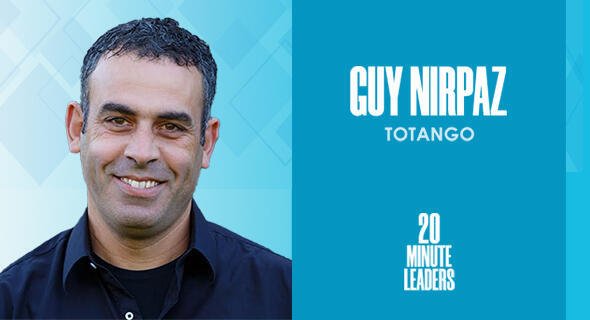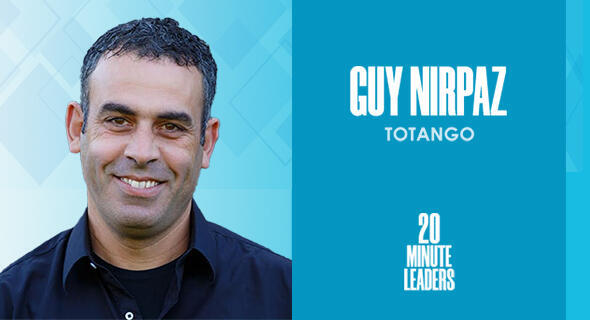
20-Minute Leaders
“The recurring revenue model in subscription puts a lot of effort on the vendor to create value to their customers.”
Customer success was not frequently talked about when Guy Nirpaz founded Totango, but he could see that the shift to subscription models would make it crucial for companies to understand and improve the journey
Customer success was not frequently talked about when Guy Nirpaz founded Totango, but he could see that the shift to subscription models would make it crucial for companies to understand and improve the journey. He explains that the recurring revenue model requires the vendor to continue to create and deliver value to customers to keep their business. While that provided a new challenge for companies, the move to the cloud also provided the opportunity to gather much more information about users and how the product is being used. Nirpaz, the CEO, shares that he is grateful that Totango’s solution was available when the market started to transform. Even with the right concept and technology, he says tech companies still need to sell more, so Totango looked for ways to make their platform more practical for companies who were very new to focusing on the customer success journey.
You’ve had quite a journey in customer success. Ten years ago, I didn't hear too much about it. But you already had founded Totango. What I'm curious about is the beginning of the journey.
At the beginning, one of the areas that were exploding was SaaS and subscription. We decided to focus on application. The area we want to tackle is the new relationship between the companies and their customers. It was clear that the recurring revenue model in subscription puts a lot of effort on the vendor to create value to their customers.
I was talking to one of the previous CEOs that I worked for, a very big company, and asked him about the need to focus on delivering value to customers, and he said, "It was never our core motivation and investment. We made sure that we market and sell and support them. From that point onwards, it's the customer's problem." We thought that the mindset has to change. If customers have an easy way to switch to an alternative, it's on the vendor to make sure that value is being delivered.
Before, very few companies had solutions for a given problem and therefore once they market and sell, it was on the customer to retain themselves. Today, with various competitors in every domain, you actually have to keep selling them even once they're already sold.
Back in the day, it was very expensive to buy software and the implementation took a very long time. Now that it's very relatively inexpensive, the power shifted dramatically into the hands of the customer. Subscription is a business model that provides more value to the customer than to the company. Back in the day, the company would collect all the money upfront. Now, you’ve got to work for your money over time. It forces companies to think customers first.
As you built out Totango, how do you pinpoint how to do that?
Our core was that the challenge is the relationship where you have to deliver value. But the advantage is that once everything moves to the cloud, you've got tons of information about your customer. You can really understand who's using the product, how they're using it, which features they're using. You can always identify where the value is being delivered and what are the gaps and drive decisions based on that. The opportunity in the transition to cloud is that it's all connected.
You're saying companies are moving to the cloud, therefore a lot of the data that they're collecting is more accessible. You can build a solution that takes in this data, even helps them collect it, and provides them with actionable insights.
Yes. Very quickly, we realized that the path of attack to this market is through the revenue. There's basically three components of revenue. Two of them are being addressed by Totango in customer success: retaining customers and growing existing customers. Companies that take the existing customers and grow, they are very good businesses because they can work with their customers to drive more value.
The market has shifted into: how do I start, what do I do first, and how should I think about this? A decade ago it was: What are you talking about? We're very grateful that we had a solution in the market at the right point in time to be able to take advantage of the market transformation.
How do you manage working with thousands of clients, each of them unique, each of them thinking through their customers in a different way, as a service company?
We chose to be a software company a hundred percent. Our gross margin is close to 80%, which means that we barely sell services. Every company is different and selling a business solution to a company that talks about their relationship with their customers is tricky. Although every company is different, every company, once it sells to its customers, wants to onboard them quickly on their platform, and then they want to make sure that they're getting value by looking at product adoption. They want to maximize renewal.
We've created this new concept called modularity around customer success where we have modules, we call them SuccessBLOCs, that allow companies to start at one point in time on their journey. Secondly, we've added a lot of best practices and templates that allow people to get started very quickly. These are examples where companies can actually learn from what others have been doing, and then customize this to their needs. The last point: we chose to roll this out in a self-service model. So Totango, as of 2020, is a self-service business with a freemium business model. We are basically solving the learning gap where people need to understand what it is and how to get started by giving free access to all of that for people to quickly learn. Once they learn, we can have a much more meaningful conversation.
We announced this concept of composable customer success. To solve the challenge of where to get started, you need composable customer success that allows you to get day one value, continuously recalibrate your processes, and ensure predictable growth. I think this is where the market is right now.
What you're saying is that if you're looking at this pyramid where the top of the pyramid is this very fine tuned customer success journey for your own company, first, you need to have this common foundation. You’re first allowing companies visibility into what's happening in those journeys. Then through composability modularity, you're allowing them to customize. Right?
Yeah. We build our product as composable, so you've got the modules and they're pre-integrated, they're built on the same data model, the same workflow model, and so forth. We did this not just because it's a good architecture concept, it's also because we wanted to reduce the barrier to entry for a company, any size, in customer success.
If your only problem, as you see it, is onboarding new customers, okay, let's just focus on onboarding first. This flexibility allows for companies to reduce those barriers to adopt, to get started, and then learn that actually customer success is about the customer and about the journey. It's not about their function; it's actually a consistent, predictable good user experience.
But when you are a technology company like ours, you've got to be practical. It's not enough that the concept is good and true, you actually need to sell technology, so you've got to make it super practical to wrap their heads around it.
Has this world or the thinking process behind your own customer journey thesis evolved much in the last few years?
Yes. What I learned is, and that was always the challenge in our market, that customer success is many things to many people. Everyone wants to retain customers and to grow their customer base and have all users as fans. That's the ultimate outcome of that. But what does it mean, how to do it, and so forth, there are so many flavors that we had to create at least a common language. I had to realize that if we are not specifying in a more easy language to understand what it is that you're trying to do and how you do it, it becomes very tricky for people to communicate.
Michael Matias, Forbes 30 Under 30, is the author of Age is Only an Int: Lessons I Learned as a Young Entrepreneur. He studies Artificial Intelligence at Stanford University, is a Venture Partner at J-Ventures and was an engineer at Hippo Insurance. Matias previously served as an officer in the 8200 unit. 20MinuteLeaders is a tech entrepreneurship interview series featuring one-on-one interviews with fascinating founders, innovators and thought leaders sharing their journeys and experiences.
Contributing editors: Michael Matias, Megan Ryan















